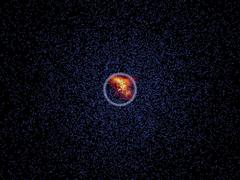URL: https://www.desy.de/news/news_search/index_eng.html
Breadcrumb Navigation
DESY News: The Crab Nebula seen in Gamma Rays
News
News from the DESY research centre
The Crab Nebula seen in Gamma Rays
The Crab Nebula is the remnant of a supernova in our Galaxy which was observed almost 1000 years ago. Although it corresponds to one of the most studied celestial objects, its extension in very high energy gamma-rays has up to now remained unknown. The international team of scientists of the H.E.S.S. telescopes in Namibia now finally succeeded to measure the extension of the Crab Nebula in very high energy gamma-rays.

The X-ray emission from the Crab Nebula as imaged with the Chandra telescope is shown in the centre in yellow/orange (image courtesy of M. C. Weisskopf and J. J. Kolodziejczak). The blue points denote the reconstructed directions of gamma-ray events as measured with the H.E.S.S. telescopes. The white circle shows the corresponding extension of the Crab Nebula as derived by the H.E.S.S. scientists. Credit: H.E.S.S. collaboration
Since the first detection of very high energy gamma-rays from the Crab Nebula with ground-based gamma-ray telescopes in 1989, it could not be distinguished from a point source. The reason for that was the comparably poor angular resolution of the telescopes. They do not measure the cosmic gamma rays directly, but record particle showers triggered when cosmic gamma quanta enter Earth's atmosphere. The particles in these showers produce a bluish glow, called Cherenkov light, which is recorded by the specialised telescopes. From this measurement it is possible to reconstruct the direction of origin of the original cosmic gamma quantum.
The accuracy of the direction reconstruction depends considerably on various factors such as the observation conditions. It can be increased with complex simulation calculations. “For the first time, a novel simulation environment was used for this measurement, which takes into account the conditions when observing the Crab Nebula at an unprecedented level of detail,” reports Stefan Ohm, Head of the H.E.S.S. Group at DESY. This has drastically increased the accuracy. “The measured extent of the Crab Nebula is about two and a half times smaller than the mean directional inaccuracy per gamma particle,” underlines Ohm.

“A comparison of the extension of the Crab Nebula at different energies shows a good agreement with theoretical models,” adds DESY theoretician Andrew Taylor. The nebula exhibits a very high energy gamma-ray extension that is larger than that in X-rays but smaller than the one in the ultraviolet regime. “The main reasons for this behaviour are the respective energies of the electrons and positrons,” explains Taylor. “With increasing energy, the particles are concentrated more towards the centre.” As the particle energies that are responsible for the emission of gamma-rays lie in between the ones of the other two mentioned ranges, the same follows for the extension of the Crab Nebula in gamma-rays. “The confirmation of this expectation by H.E.S.S. is a nice example for the importance of both theory and experiment”, Berge points out.
Reference: Resolving the Crab pulsar wind nebula at teraelectronvolt energies; H.E.S.S. Collaboration (H. Abdalla et al.); Nature Astronomy, 2019; DOI: 10.1038/s41550-019-0910-0



